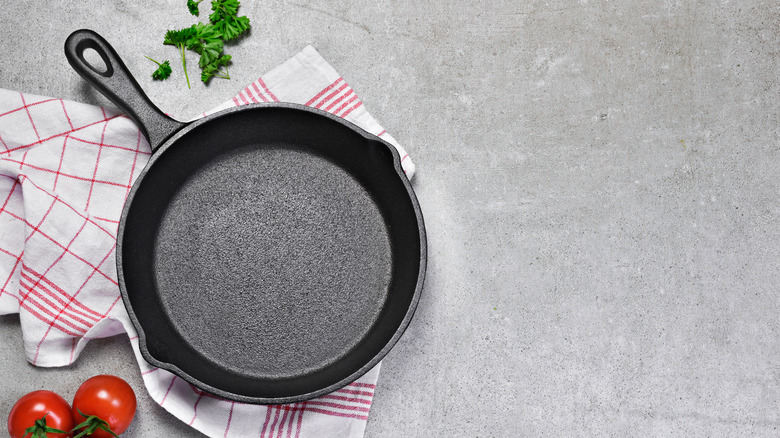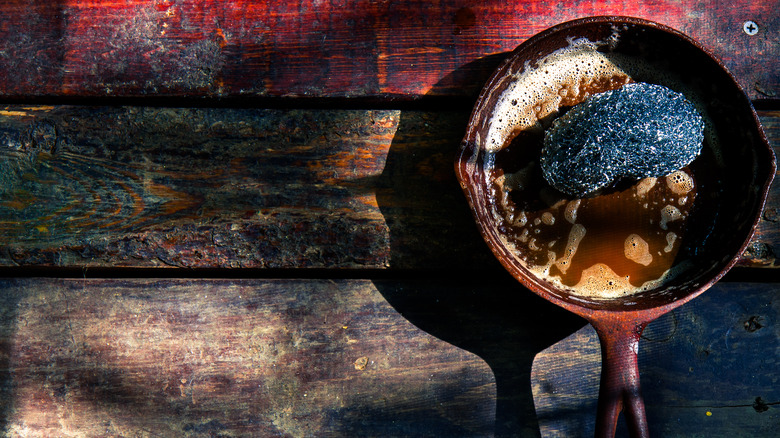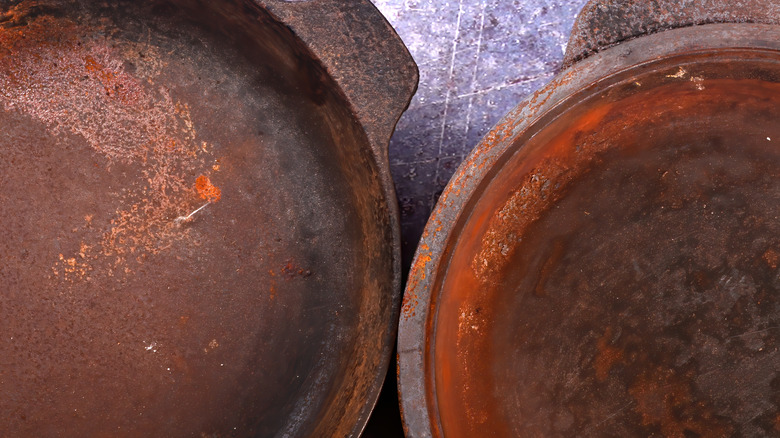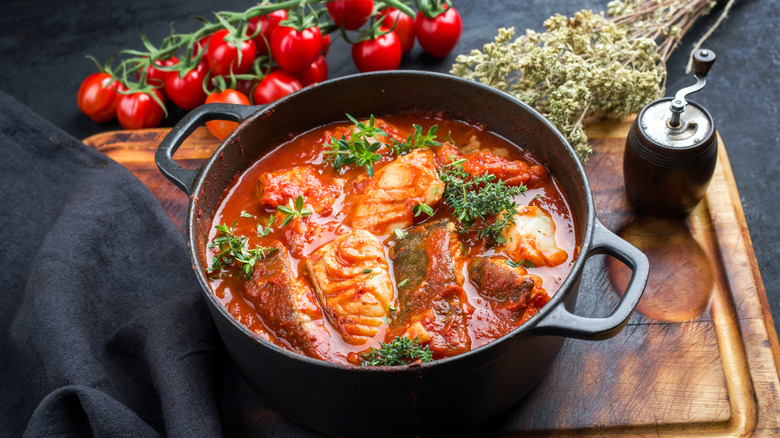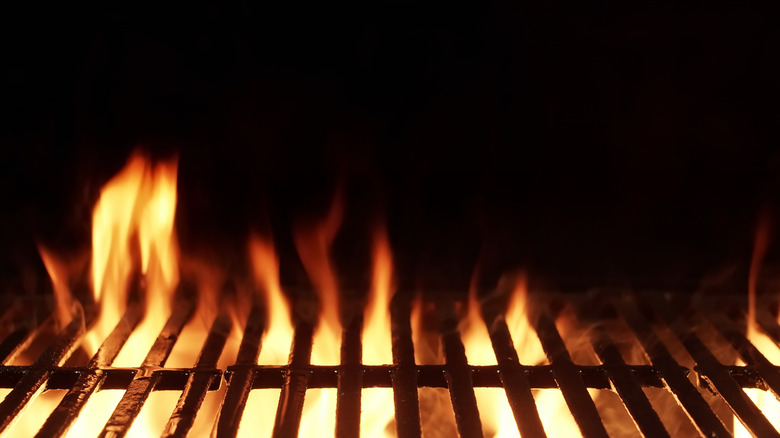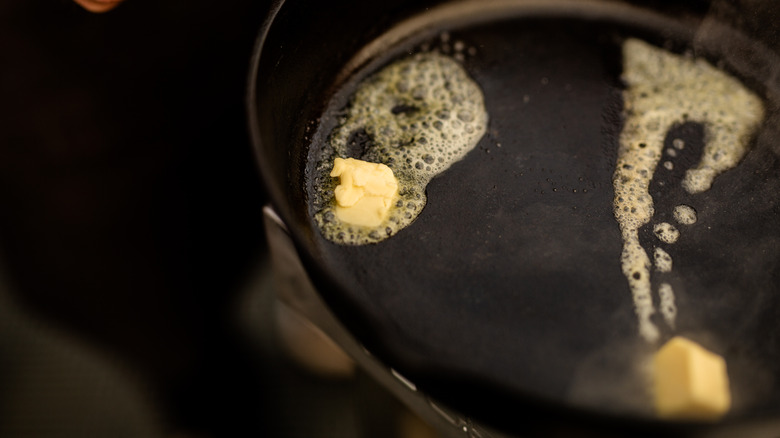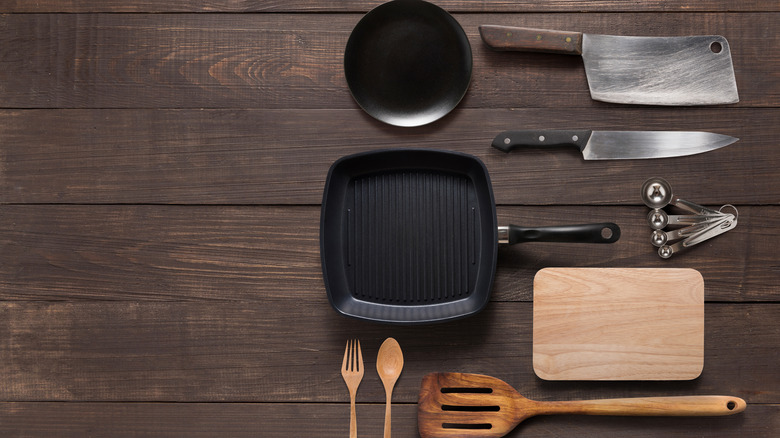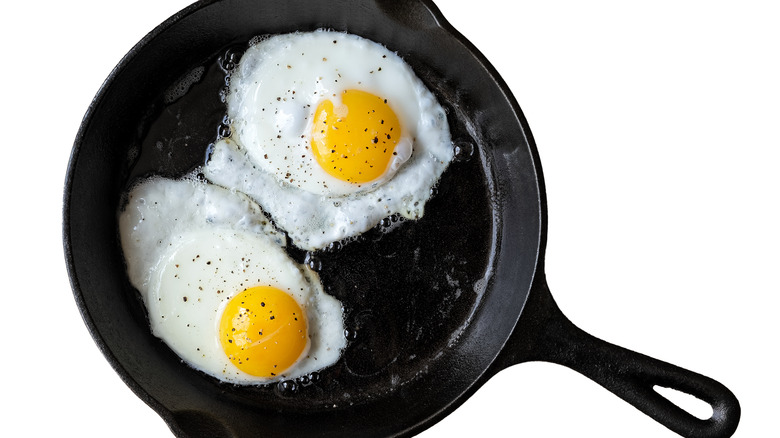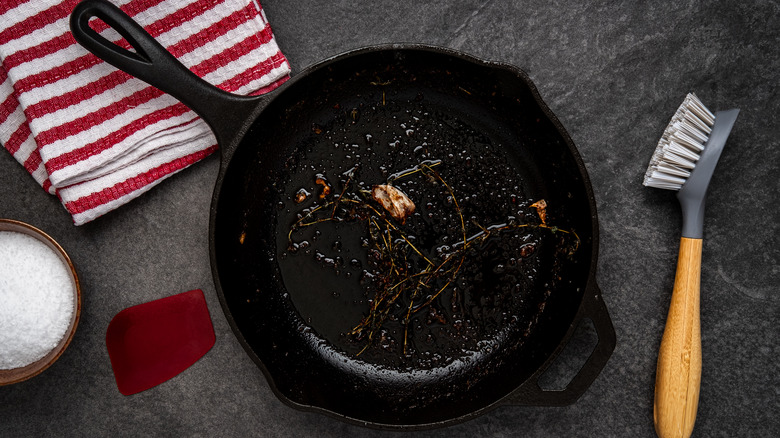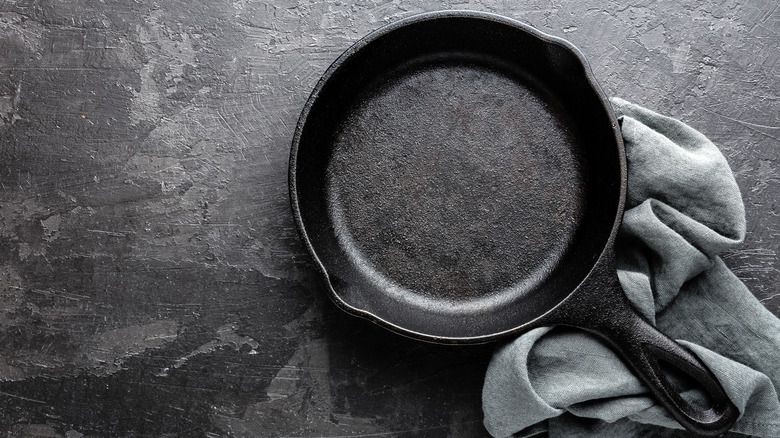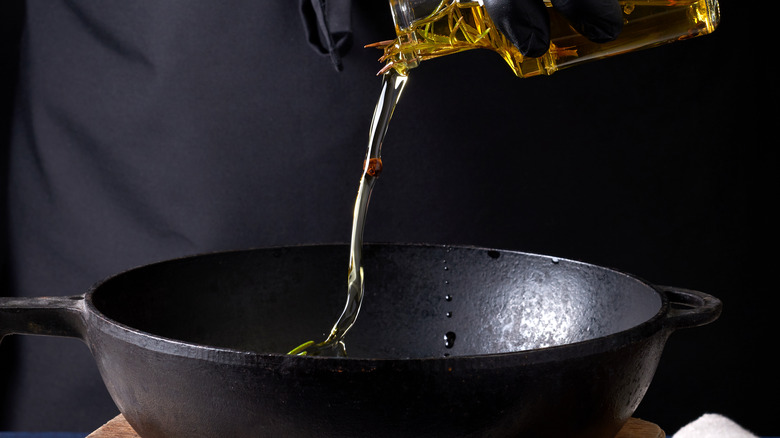The Truth About Cast Iron Pans
To the uninitiated, cast iron pans have somewhat of an air of mystery about them. Maybe you've heard that you can't use soap on them, or that you have to coat them in specialized oil to keep them from rotting away into a pile of rust. That's definitely more complicated than working with a nonstick pan or a run-of-the-mill aluminum set, right? But neither of these concerns about cast iron pans is true. In fact, there are a whole lot of misunderstandings about cast iron that are keeping people from fully enjoying what should be a stalwart kitchen workhorse.
The fact is, cast iron pans aren't necessarily more difficult to work with than other cookware. They're just different. And with different construction comes different care needs, like never letting your cast iron air dry and being careful with how you move it about your kitchen.
If you've previously been averse to this style of cookware, think again. Cast iron lovers like Alton Brown prize the cookware's versatility, exceptional durability, ease of switching between oven and stovetop, and ability to retain heat extremely well. There are many benefits — and, yes, some drawbacks — to using cast iron cookware. If you're confused about how to use, care for, and make the most out of cast iron pans, it's time to learn the truth.
Cast iron isn't delicate
Simply put, cast iron pans aren't maintained the same way as other pans. For example, it's not common to use soap to clean them, though you're free to reach for the soap with other styles of pans. Also, you should never store them wet, and you'll want to build up a coating of oil-based seasoning on cast iron over time. These differences can lead to a misconception that they're finicky and delicate to work with.
The idea that cast iron pans are delicate is just not true. If it was, we wouldn't be able to find decades-old pans at thrift shops and garage sales or passed down over generations. Though, that said, you should be careful handling cast iron pans. That's because they're heavy and solid enough to damage your stovetop, countertop, or kitchen floors — not the other way around. However, just stay mindful of where and how you're moving that big cast iron pan and you should be perfectly fine.
According to Serious Eats, these metal pans are about as tough and resilient as you can get in cookware. And if you've chipped off the pan's seasoning, you can always build up more over time as you cook. Found some rust? No problem. Just buff it out with steel wool and cover it with oil. Compare that to a non-stick pan that has to be pampered and tossed at the first sign of a surface scratch. Not so delicate now, is it?
You can use soap on cast iron
You've probably heard you shouldn't use soap on a cast iron pan. The truth is, you can use a little soap on cast iron if you want to, according to Lodge Cast Iron and even celebrity chef Alex Guarnaschelli. You just have to be thoughtful about how you do it.
The idea behind not using soap on cast iron is all about oil. The thinking is that dish soap is highly effective at washing away oils and dirt. However, oil is what helps build up your cast iron pan's seasoning. So by using dish soap, you'd strip away your pan's all-important seasoning, which helps to keep food from sticking to the pan's surface.
But that concern, while logical enough on the surface, isn't necessarily reality. Soap won't remove your seasoning because the seasoning is built up by polymerization, a process that happens when hot oil melds with the surface of the pan (via The Kitchn). Soap won't take that off, though extremely high temperatures will. That said, while you can use soap, it's not necessary to clean a cast iron pan if you really want to skip the stuff. Oil and coarse salt can remove food pieces pretty well as you scrub. All you need to do is rinse and dry the pan once you're done, and you'll have a clean cast iron pan without the use of soap.
Rust isn't the end of the world for your cast iron
A bright orange rusty buildup is cause for concern on any surface, including cast iron pans. But rust doesn't mean it's time to part with your cast iron pan, as Southern Living reports. A pan can come back to life, even if you once thought it was an irredeemable mess.
Lodge calls out common culprits of cast iron pan rust, such as running a pan through the dishwasher, leaving it to soak in the sink, air drying, or storing it in a humid environment. Taking steps to avoid these situations will save you a lot of work in the first place.
If rust has already shown up on your cast iron, Taste of Home reports that you can remove it by scrubbing it with dish soap and steel wool or a stiff brush. You should scrub until you don't see orange anymore. Instead, you should see black, the color of the unoxidized iron beneath the rust. Then, rinse, buff, and dry your pan thoroughly. Finally, you'll need to reseason it with oil. Spread the oil around the entire pan and put it in a 350° F oven upside down on the upper rack for about an hour. Protect your oven from oil drips with aluminum foil or a sheet pan placed beneath on the bottom rack. Turn off the oven, let the pan cool, then repeat the process a second time for a full seasoning.
It's okay to cook acidic foods in cast iron
You may have been told not to cook acidic foods in cast iron, either for taste or health concerns or worries about damaging that seasoning (and the process of re-seasoning a pan does take a bit of extra time). Now, there is some truth to this idea. America's Test Kitchen reports that the trace amounts of metal that can come loose when cooking acidic food can impart a metallic flavor to the final dish. So if you're slow-cooking a tomato-based stew or soup in cast iron, you might taste it and find the flavor unpleasant or at least a bit different than what you were expecting.
However, these small amounts of metal aren't dangerous to your health. After all, it's iron, and we need some iron in our diets to stay healthy. The concern that the acid can eat away at your pan's seasoning is valid to a point, but America's Test Kitchen didn't find any issues on this front with a well-seasoned pan. And if you do run into seasoning issues with acidic food in cast iron, you can always reseason your pan.
Burning cast iron can damage your pan
Cast iron is pretty tough, but bringing it into contact with fire is a step too far for even this type of cookware. You may have heard you can burn off built-up food or rust from cast iron pans. That's perhaps an idea held over from frontier days with fewer options for cleaning, but surely we're beyond that now.
While fire can remove food and rust, it can also seriously damage your pan, according to The Cast Iron Collector. Think about it: cast iron pans are created by heating the metal up to extremely high temperatures and then forming it in a mold. Heat it up to extremely high temperatures again and you could have serious structural problems like warping or cracking. It could even take on a scaly texture.
The best way to restore a cast iron pan with buildup or rust is a good scrub, whether it's with oil and salt or soap and steel wool. After that, you should reseason and keep the pan dry. Just remember that some old-fashioned elbow grease is better than throwing your cast iron pan into the fire.
Cast iron doesn't heat evenly
Unlike some other types of cookware that heat up quickly and evenly, cast iron heats slowly and doesn't offer even distribution of heat, per Webstaurant Store. You may end up with cold spots on the cooking surface, which can be a problem if you're cooking something that needs to be consistently heated across the entirety of the pan.
To deal with this reality, you could move food around the pan routinely so every piece theoretically should hit a hot spot and will hopefully cook through. Or, if you prefer, you can get more consistency with other options. Cast iron can easily move from the stove to the oven, and vice versa. That means you can preheat your pan for about 10 to 15 minutes either in your oven or on the stovetop before you use it. You'll just need to remember to handle it carefully if you've moved it from your oven to the stove. Also, be aware that the pan is, of course, going to be hot. As you add food to it, you may experience some sizzle and fast cooking, at least initially.
It's fine to use regular utensils on cast iron
It's common to use wooden or non-stick utensils on cast iron pans, but that's not completely necessary. The general concern is that using metal utensils could scrape off the seasoning. If you're working with a new cast iron pan or you've just started building up a new seasoning, then it's true that you should be cautious about which utensils you use, as Chowhound notes. Ideally, you'll use silicone or wooden utensils in such a situation, as they're gentlest on pan surfaces.
But it's not a problem to use metal utensils if your cast iron pan has a well-built up seasoning. That seasoning is tougher than a new one and is not likely to scratch or chip with routine utensil use. If you do notice a few scratches or flakes, be sure to recoat your cast iron with some oil after you're done cleaning it. Some cast iron pan owners add oil to the pan after every use to protect it from moisture, too.
Food may stick to cast iron
Let's get things straight: cast iron pans simply aren't at the same level of nonstick as Teflon-coated pans. While Teflon is a coating that's specifically engineered to avoid food sticking to pans, cast iron just isn't designed the same way, as Oola reports.
Yes, a cast iron pan that has a good seasoning should make it fairly slick, all so it's easy to work with and makes it simple to remove food from the pan's surface. You might even be able to get eggs or other foods that commonly stick to pans to slide off of a cast iron pan with little effort — again, assuming that the seasoning in the pan is just right.
However, the reality is you'll need to use oil to keep this kind of food from sticking to your cast iron pan. If you need a nonstick pan that works without oil, cast iron just isn't the best choice. Instead, you should go for a pan that's truly non-stick, so long as you promise not to overheat the pan.
Seasoning a cast iron pan is fairly simple
The idea of seasoning cast iron can be intimidating, at least the first time. If you're used to running cookware in the dishwasher (don't do that to nonstick, by the way) or giving it a good soapy scrub and drip dry, the cast iron cleaning process is, well, different. You might even be a little confused about adding oil to the pan to maintain it because, in other pans, oil is something you'd want to clean up.
Cast iron pans typically come preseasoned, and as you cook with oil and fat, you'll naturally add to it over time. Lodge recommends maintaining your cast iron pan seasoning just by cooking with it and cleaning your pan properly. That process includes rubbing oil into the pan after using it.
If you want to build up a more ironclad seasoning or you're dealing with a rusty pan, you can season it in the oven in about an hour with just oil and aluminum foil, per Field Company. Once you've done it a couple of times, you'll learn that seasoning your cast iron is actually not half bad.
Cast iron is easy to clean
Cleaning a cast iron pan is different from cleaning other types of pans, but it's not more difficult. Instead of soaking pans to loosen food and using soapy water, cast iron pans are easily and simply cleaned with hot water and a good scrub.
When you clean a cast iron pan, you'll use water and a stiff brush or sponge (via SheKnows). For stubborn food, throw on some coarse salt to add to your scrubbing power. If that's not enough, you can go so far as to use steel wool and follow up with an oil coating. You should always fully dry your cast iron before you put it away, as air drying can cause rust that you'll have to scrape off and reseason. Likewise, you shouldn't ever soak your cast iron pan in water or keep it wet for an extended period of time — that's rust city. Generally, cast iron is seasoned well enough that food doesn't stay stuck on easily and you should enjoy a fairly simple cleaning process.
Seasoning oil choice matters
As you may have guessed by now, oil is key to seasoning a cast iron pan. However, oil choice isn't always an exact science. While a new pan likely has a well-seasoned patina that you can add to with whatever oils and fats you're using to cook your food, a pan that's in need of a new seasoning will benefit best from a particular type of oil.
Field Company has a specific recommendation for seasoning oil in just such a situation. "When selecting a seasoning oil, you want one that's high in polyunsaturated fats and has a high ratio of polyunsaturated fat to monounsaturated fat." This type of oil lends itself well to the polymerization process that creates the all-important seasoning on cast iron pans. You could buy blended seasoning oil from cast iron pan companies, but grocery store cooking oils that could work just as well are grapeseed oil and sunflower oil. Want to build up a good seasoning over time without endlessly reseasoning? Just use these oils as you cook and clean your cast iron pan.

